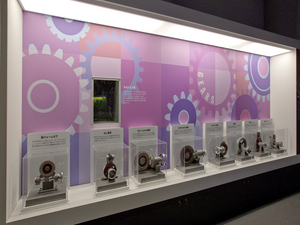Nagoya City Science Museum
TOP > Exhibition Guide > Keyword Search > Starting with "W" > work > Gears
Gears



Purpose of Exhibition
When machines are being disassembled, you can see various components. It cannot be decomposed further. The gear is perhaps one of the most important components of any machine.
There are many kinds of gears. The eight interactive exhibition, which combines gears, is displayed. We would like you to pay attention to input and output. In other words, what rotation does the gear need to turn a particular direction and how much do you rotate them. You can strongly feel the original idea of how the power is transmitted. The purpose of this exhibition is to deepen your understanding about gears and how they work.
Additional Knowledge
[Japanese Clock and the Gears]
We would like to show you a western style clock that was introduced to Japan in the 17th century, and the subsequent reformation of the clock to Japanese style. Also, we'd like to introduce the propagation of the gear making technique used for wind-up dolls and explain the history of gears that were used in them. Ieyasu Tokugawa was given a clock from Korea around 1600.
However, unfortunately, the clock was broken and he had to look for a repair person. Mr. Sukezaemon Tsuda who was a craftsman of ornaments (what we might call a modern-day metalworker), in Kyoto was selected. He investigated the broken clock thoroughly and made two exact same clocks. After that, he was accredited with the achievement and got accepted by Ieyasu as a retainer. He was engaged in the Owari branch.
At that time, the gears were set in the clock. It used to be cut from steel and shaped precisely by rasping. A high level of accuracy was required to make gears. The interval between the peaks of gears was called the "pitch". Only when pitches are exactly corresponding to any part of the gears, does the meshed tooth rotate smoothly. It must have taken so much time to make even a single gear at that time. Nowadays, a machine tool called a gear-cutting machine can cut it precisely.
Handguard was the processing technique for steel in those days. When you look at the watermarked handguard (Figure 1), you can see its high quality. It was decorated by making a hole and shaving from there by rasping. The watermarked handguards were produced in Owari, and the monuments of watermarked handguard are displayed in front of Nagoya city museum.
The gift which Ieyasu received was a western style clock. The character of a western style clock follows the Italian system of hours that divides one day equally. It is the same as today's clocks. However, Japan used the temporal hour that divided each day and night into six hours, and the clock which Ieyasu received did not work in Japan. Therefore, Tsuda adjusted the Japanese clock to the temporal hour system through a process of trial and error.
[Wind-up Doll and Gears]
This technique had been applied to the Wind-up doll. An important part of a clock is the escapement. It plays an important role in releasing the energy at a steady speed. Because this role is explained in "Mechanical Clocks", we won't introduce further details here. The Tea Server Robot has the escapement (photo). You can check it at the exhibition.
There is another important point. Although the parts of a clock were made of steel or brass hammers (from the late Edo period), the parts of the Tea Server Robot were made of wood. You might think the wood is softer than steel and it is easier to convert parts, however, it is not always like that. Let's see the big gears attached to the left side of the tea-serving doll. You can see that it was made not by cutting and shaving from the board of a big tree, but by dividing it into 8 parts and combining them to form one gear. You can also find that the fiber of the wood is directly radiating from the center part of the gear. If the gear is cut from a big tree, the fibers of wood are in one direction, the gears are meshing and it makes cleavage parts when adding force. This needs to be prevented, and so this is the reason why the complicated processing method was applied. In this case, at the connecting points the space between the peaks, or more specifically, the pitch, should be the same as the other parts. The more difficult design and processing accuracy were acquired.
Cooperation: Shobee TAMAYA VIIArticle by Koichi Mabuchi
